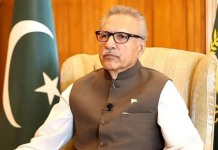ISLAMABAD, Dec 14 (APP): The massive torrential rain floods in 2022 caused widespread devastation as the country’s almost one-third areas, mainly in Sindh and Balochistan, got submerged, fully grown crops washed away, and road infrastructure wiped out at a large scale leaving the flood-impacted regions completely inaccessible for days.
Despite limited resources and financial constraints, the coalition government, under the dynamic leadership of Shehbaz Sharif, exhibited collective wisdom that greatly helped save precious lives in the flood-affected areas and ensure timely relief and rehabilitation measures after the country started enduring unmatched monsoon downpours started in June this year where over six-month coordinated effort helped reaching out to the flood impacted awaiting help.
Without wasting any time, the government established the National Flood Response and Coordination Centre (NFRCC) comprising representatives of federal stakeholders, provincial governments and the Pakistan Armed Forces that oversaw the national response to the monsoon rains and floods.
In the provinces, the PDMAs established sector coordination mechanisms to ensure better response coordination in partnership with the humanitarian community.
The coordination between humanitarian partners with the district disaster management authorities (DDMAs) evolved to allow for more timely and effective information sharing and strengthened district-level coordination.
The severe monsoon weather caused extensive flooding and landslides casting grave impacts on human lives, property and infrastructure.
The government was leading the humanitarian response for people in the affected areas, supported by the UN and humanitarian partners. The floods have impacted some 33 million masses looking for assistance whereas the UN and the international humanitarian community intended to cover around 5.2 million people in Pakistan over the next six months under the 2022 Pakistan Floods Response Plan.
Federal Minister for Climate Change, Senator Sherry Rehman said the scale of the disaster was so big that for the first time the largest inland deployment of Pakistan Navy troops was made to drive rescue and relief efforts.
Senator Sherry Rehman said, “Let’s not talk about pollyanna sustainable economics. First, we have to get those people on their feet.”
The Minister claimed that there was an unimaginable scale of loss and damage caused by unprecedented climate-induced floods in Pakistan. She underscored that the magnitude of calamity was beyond all previous climate disasters, affecting a population larger than the size of many countries.
Federal Minister for Commerce, Syed Naveed Qamar was of the view that Pakistan was at the heart disasters after disastrous floods and in many ways at present it would be starting from the scratch in building forward better.
The Minister noted that the country in 2010 and 2011 witnessed floods but after a decade the same occurred whereas if we had to repeat the same things then it was wrong with the governance model.
“The world helps us or not we will have to support our people within our limited resources. The flood losses estimate by Pakistan accounts for $32 billion and the world estimates $16 billion but no one knows how much will be gathered. The most of the funding will be coming from within.”
Minister of State for Finance and Revenue, Dr Aisha Ghaus Pasha said the floods in Pakistan incurred huge economic and collateral damages leaving over half a million expecting mothers without home and under open skies which is a catastrophe.
The whole effort was mammoth but the UN and donor agencies and friendly countries helped and supported the relief and rehabilitation efforts.
The floods have left life losses of 1,739 innocent souls, 12,867 injured, whopping deaths of 1,164,270 livestock animals and a towering pile of 2,288,481 houses damaged in various areas across the country during the floods.
Some 84 districts of various federating units including 32 in Balochistan, nine in Gilgit Baltistan, 17 in Khyber Pakhtunkhwa, three in Punjab, and 23 in Sindh. The United Nations Office for the Coordination of Humanitarian Affairs (UNOCHA) situation report on Pakistan: 2022 Monsoon Floods provides a detailed account of the disaster damages and response of the government, the donor agencies, and departments concerned to manage the post-disaster situation.
The floodwater stagnation in below sea level terrain in the provinces of Sindh and Balochistan aggravated the outbreak of waterborne diseases and epidemics further enhancing the vulnerability of the already distressed communities. The Provincial Disaster Management Authority (PDMA) Sindh claimed that an estimated 240,000 people remain displaced from their homes in the Province as of December 3 whereas the number had receded from 6.5 million displaced masses in early September.
The report states that around 90% of flood-displaced people were reportedly with host communities, while the remaining in tent cities and relief camps. It further underlined that since millions of people have repatriated to their native towns after declining flood waters but there have been reports of substantial service gaps in those areas alongwith wide-ranging impacts to homes, agriculture, and livelihoods.
However, the situation of health crisis revealed in the report noted that the cases of malaria, cholera, acute watery diarrhea, and dengue were reducing, but it remained concerning in some of the flood affected districts with a dearth of medicine also reported in some remote health facilities.
The UNOCHA estimates claim that failing food insecurity would push additional 1.1 million people into Integrated Food Security Phase Classification in emergency phase (IPC 4) in early 2023.
Despite, the fact that floodwaters continued receding in many flood-affected areas whereas the water stagnation persisted in Dadu, Kambar, Shahdad Kot, Khairpur, Mirpur Khas, Jamshoro, Sanghar, Umer Kot, Badin, Shaheed Benazir Abad and Naushahro Feroze districts in Sindh and Sohbatpur and Jaffarabad districts in Balochistan.
“United Nations Satellite Centre (UNOSAT) imagery indicates an estimated 8 million people still potentially exposed to floodwaters or living close to flooded areas,” the UNOCHA report said.
The World Health Organization (WHO) said that cases of malaria, cholera, acute watery diarrheal diseases, and dengue fever were dropping in most of the flood-affected districts.
“Overall, malaria cases have reduced to around 50,000 from over 100,000 confirmed cases in early October. Malaria cases have declined by 25% in Balochistan, 58% in Khyber Pakhtunkhwa (KP) and 67% in Sindh provinces. However, high malaria and cholera cases are still being reported in some pocket districts in Sindh and Balochistan where standing water remains.”
Moreover, the report claims that in November 2022, around 70 suspected cases of Diphtheria were reported from the flood-affected provinces of KP, Sindh, and Punjab.
The National Disaster Management Authority (NDMA) in November organized the first winter contingency and preparedness planning conference as a proactive measure to save lives and infrastructure during the winter.
Furthermore, a number of bilateral partners provided in-kind assistance to the government to support agricultural production. The Turkish Cooperation and Coordination Agency (TIKA) provided 60 tons of wheat seeds to approximately 700 small-scale farmers in the eight most affected districts of Sindh to boost food production. TIKA in cooperation with Sindh Agricultural University, Tandojam, and the Rural Agriculture Extension Department of the Sindh Government provided wheat seeds to small-scale farmers to increase local food production.
In addition, Japan International Cooperation Agency (JICA) provided 12,500 certified wheat seed bags to flood-affected farmers in five districts of Naseerabad, Jaffarabad, Sohbatpur, Jhal Magsi, and Kachhi in Balochistan Province.
The assistance will enable 2,500 flood-affected families to cultivate wheat crops during the Rabi agricultural season. International and national NGOs continue to support people with food, health, non-food items (NFIs), water, sanitation, and hygiene (WASH).
Pakistan Humanitarian Forum (PHF) members had reached 3.8 million people through its humanitarian response in food, shelter, education, NFIs, WASH, cash, health, and protection in 82 flood-affected districts.
The Pakistan Red Crescent Society (PRCS) through the Red Cross and Red Crescent Federation-wide support had reached over 584,000 people with lifesaving assistance in shelter, health, WASH, food and non-food sectors.
The PRCS prioritized lifesaving food, water, medical, and shelter assistance in the first phase of the response but is now focusing on preventative public health interventions complementing health and WASH services.














